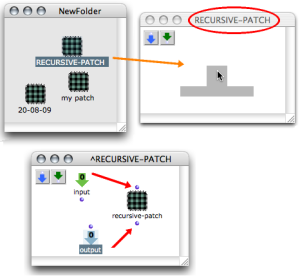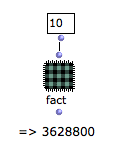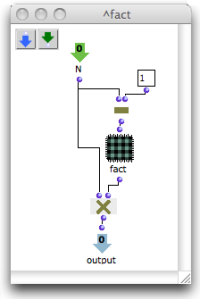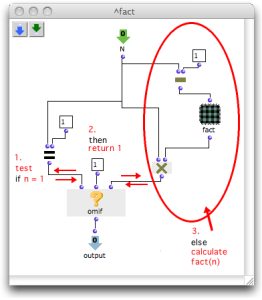| Navigation : Previous | Next |
Recursion in OM
Creating a Recursion
A recursive program can be designed putting the reference of a blue patch in its own editor - that is, putting a patch within itself .
 Creating a recursion : a patch is dropped into its own editor.
Creating a recursion : a patch is dropped into its own editor.
If this patch has inputs and outputs, they will also appear on the patch box, so that the patch can be “called from inside itself”.

Infinite Calls / Termination
A termination condition is absolutely necessary in a recursive patch. Otherwise, a succession of infinite calls will be triggered at the evaluation.
Remind to save all your material before calling a recursive patch.
Internal Patch Recursion
Do not ever build recursive programs with internal - red - patches, or with OMLoop boxes. A function has to be global to apply within itself.
Example: Factorial Patch
This recursive patch implements a preliminary version of the factorial function. It is called inside itself and calculates fact(n) = n x fact(n-1).
This function has no termination condition. If it is called in its current state, it will never end.
Termination :
- The n values passed recursively are strictly decreasing, since they are each time equal to n-1.
- Besides, we know that fact(1) = 1.
- Therefore, we will add a non recursive branch via omif, applying to cases where n = 1.
The resulting patch means :
if n = 1, then fact(n) = 1 else , fact(n) = n x fact(n-1)
-
When omif is evaluated, it evaluates the = test.
-
The = test returns “nil” if n ≠ 1 . It returns “t” if n = 1. This is the termination condition of the patch.
-
- omif returns the value of its second input (1), if it gets “t”.
- omif triggers the evaluation of the boxes that are connected to its third input if n ≠ 1.
- The factorial of n is calculated by om-, the fact sub patch and om*.
- omif returns the value of its second input (1), if it gets “t”.
Using Omif:

Contents :
- OpenMusic Documentation
- OM User Manual
- OpenMusic QuickStart
| Navigation : Previous | Next |

